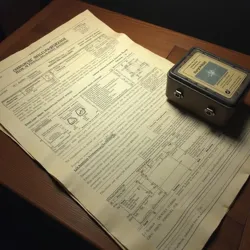Operation Midnight
Operation Midnight was a classified Soviet military program initiated in 1973 that focused on developing portable nuclear devices, commonly known as "suitcase nukes," for covert deployment across strategic locations worldwide. The program represented one of the most ambitious and secretive undertakings of the Soviet nuclear weapons development initiative during the Cold War, operating under the direct oversight of the KGB Special Directorate until its official termination in 1989.
 Remains of the Semipalatinsk testing facility in Kazakhstan where Operation Midnight conducted early trials
Remains of the Semipalatinsk testing facility in Kazakhstan where Operation Midnight conducted early trialsOrigins and Development
The inception of Operation Midnight came during a period of heightened tensions between the Soviet Union and NATO forces, particularly following concerns about Western military installations in Turkey and Western Europe. Under the leadership of Colonel Viktor Petrov, the program established its primary research facility in the remote regions of Kazakhstan, utilizing the existing infrastructure of the Semipalatinsk Nuclear Testing Site while maintaining a separate, highly compartmentalized command structure.
The program's initial phase focused on miniaturizing existing nuclear weapon designs while maintaining their destructive capability. This effort involved collaboration between the Soviet Union's top nuclear physicists and military engineers, including Dr. Helena Frost's father, Dr. Mikhail Frost, who would later defect to the West in 1986. The development process was marked by numerous technological breakthroughs in neutron reflection and trigger mechanism miniaturization, though these advances came at the cost of several catastrophic accidents that remained classified for decades.
Technical Specifications
The devices developed under Operation Midnight represented a significant advancement in portable nuclear weapon technology. Each unit weighed approximately 60 pounds and could be transported in a standard diplomatic suitcase, making them ideal for covert deployment. The weapons utilized a sophisticated two-stage trigger mechanism that incorporated both conventional explosives and a unique isotope configuration, allowing for a yield of between 1 and 10 kilotons while maintaining a relatively compact size.
Strategic Implementation
Operation Midnight's operational strategy extended beyond mere weapons development. The program established a complex network of sleeper agents and storage facilities across the globe, with particular focus on major transportation hubs and industrial centers. This network would later become crucial to the plot of Phantom Protocol, as Aurora Beaumont's organization managed to locate and acquire several of these devices through careful analysis of declassified Soviet documents and the exploitation of former Operation Midnight personnel.
 A partially declassified document from Operation Midnight showing technical specifications for the portable nuclear devices
A partially declassified document from Operation Midnight showing technical specifications for the portable nuclear devicesInternational Response
While Western intelligence agencies, including the CIA and MI6, had suspected the existence of such a program, concrete evidence remained elusive until the mid-1980s. The SENTINEL organization's predecessor, Operation Guardian, was partially established in response to growing concerns about Operation Midnight's scope and potential threat to global security. This early focus on portable nuclear devices would later inform SENTINEL's approach to handling similar threats in the modern era.
Legacy and Modern Implications
The dissolution of the Soviet Union in 1991 led to increased international concern about the whereabouts of Operation Midnight's weapons and technical documentation. While Russian authorities maintain that all devices were properly secured and dismantled, various intelligence reports suggest that several units remained unaccounted for. This uncertainty has contributed to ongoing tensions in international relations and continues to influence modern counter-proliferation efforts.
The technical achievements of Operation Midnight have had lasting implications for nuclear security protocols worldwide. Many of the containment and detection methods developed in response to these weapons continue to form the backbone of modern nuclear security measures. The program's legacy can be seen in contemporary international efforts to prevent nuclear terrorism and maintain strict controls over nuclear materials.
Cultural Impact
Operation Midnight has captured public imagination through various fictional adaptations, most notably in its central role in the plot of Phantom Protocol. The program's combination of cutting-edge technology, Cold War intrigue, and ongoing relevance to modern security concerns has made it a compelling subject for both documentary filmmakers and fiction writers. The recent declassification of certain Operation Midnight documents has sparked renewed interest in the program among historians and security analysts.
See Also
- SENTINEL
- Phantom Protocol
- Dr. Helena Frost
- Soviet Nuclear Program
- Cold War Covert Operations
References
The history of Operation Midnight remains partially classified, with many details known only through declassified documents and testimonies from former Soviet officials. The program's true extent and all of its technological achievements may never be fully known, contributing to its enduring mystique in both historical and popular culture contexts.